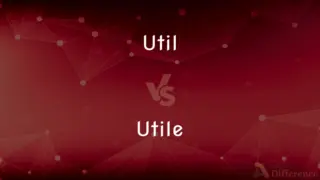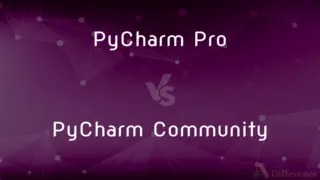Silicon vs. Germanium — What's the Difference?
By Urooj Arif & Maham Liaqat — Updated on May 7, 2024
Silicon is a widely used semiconductor in electronics due to its abundance and stability, while germanium, an earlier semiconductor material, is valued for its superior conductivity but is less prevalent.
Difference Between Silicon and Germanium
Table of Contents
ADVERTISEMENT
Key Differences
Silicon is a more abundant element on Earth and forms the basis of modern semiconductor technology. Germanium, while rarer, was historically used in early semiconductor devices before silicon became dominant.
Silicon is known for its thermal stability and high resistance to oxidation, whereas germanium is less stable at high temperatures and more prone to oxidation, limiting its use in some applications.
Both elements are used in making transistors, diodes, and other electronic components. Silicon remains the primary choice due to its low cost and wide availability, while germanium is still utilized for specific applications requiring high-speed switching.
Silicon, being abundant, is cheaper and easier to source, while germanium's higher production cost stems from its scarcity and more complex extraction processes.
Germanium transistors operate at lower voltages and have higher carrier mobility, making them suitable for high-frequency applications, whereas silicon transistors are more versatile for general electronics.
ADVERTISEMENT
Comparison Chart
Abundance
Abundant
Less abundant
Cost
Low
Relatively high
Thermal Stability
High
Moderate
Oxidation Resistance
High
Low
Applications
Universal in electronics
Specialized for high-speed devices
Compare with Definitions
Silicon
A chemical element, often used as a semiconductor.
Silicon chips are essential components in modern computers.
Germanium
A chemical element, sometimes used as a semiconductor.
Early transistors were made using germanium instead of silicon.
Silicon
The primary material for most electronic circuits.
The microprocessor is made using silicon wafers.
Germanium
A rare element known for its high electron mobility.
Germanium is used in high-speed electronic circuits due to its mobility.
Silicon
Abundant element found in sand and quartz.
Silicon is extracted from sand through a high-temperature process.
Germanium
An element with atomic number 32.
Germanium is a metalloid closely related to tin and silicon.
Silicon
An element with atomic number 14.
Silicon is classified as a metalloid on the periodic table.
Germanium
Used for infrared optics and fiber optics.
Germanium lenses are ideal for infrared imaging systems.
Silicon
The basis for transistors and diodes.
Most transistors in electronic devices are made of silicon.
Germanium
Found primarily in zinc and coal ores.
Most germanium is recovered during zinc refining.
Silicon
Silicon is a chemical element with the symbol Si and atomic number 14. It is a hard, brittle crystalline solid with a blue-grey metallic lustre, and is a tetravalent metalloid and semiconductor.
Germanium
Germanium is a chemical element with the symbol Ge and atomic number 32. It is a lustrous, hard-brittle, grayish-white metalloid in the carbon group, chemically similar to its group neighbors silicon and tin.
Silicon
A nonmetallic element occurring extensively in the earth's crust in silica and silicates, having both a brown amorphous and a gray lustrous crystalline allotrope, and used doped or in combination with other materials in glass, semiconducting devices, concrete, brick, refractories, pottery, and silicones. Atomic number 14; atomic weight 28.086; melting point 1,414°C; boiling point 3,265°C; specific gravity 2.33 (25°C); valence 2, 4. See Periodic Table.
Germanium
A brittle, crystalline, gray-white metalloid element, widely used as a semiconductor, as an alloying agent and catalyst, and in certain optical glasses. Atomic number 32; atomic weight 72.64; melting point 938.3°C; boiling point 2,833°C; specific gravity 5.323 (at 25°C); valence 2, 4. See Periodic Table.
Silicon
A nonmetallic element (symbol Si) with an atomic number of 14 and atomic weight of 28.0855.
Germanium
A nonmetallic chemical element (symbol Ge) with an atomic number of 32: a lustrous, hard-brittle, grayish-white metalloid in the carbon group.
Silicon
A single atom of this element.
Germanium
(countable) An atom of this element.
Silicon
(slang) computing
Germanium
A rare element, discovered in 1885 in a silver ore (argyrodite) at Freiberg. It is a brittle, silver-white metal, chemically intermediate between the metals and nonmetals, resembles tin, and is in general identical with the predicted ekasilicon. Symbol Ge. Atomic number 32. Atomic weight 72.59. It has excellent semiconductor properties, and is used in transistors and diodes.
Silicon
(slang) computer processor
Germanium
A brittle gray crystalline element that is a semiconducting metalloid (resembling silicon) used in transistors; occurs in germanite and argyrodite
Silicon
Abbreviation of silicon chip
Silicon
A nonmetalic element analogous to carbon. It always occurs combined in nature, and is artificially obtained in the free state, usually as a dark brown amorphous powder, or as a dark crystalline substance with a meetallic luster. Its oxide is silica, or common quartz, and in this form, or as silicates, it is, next to oxygen, the most abundant element of the earth's crust. Silicon is characteristically the element of the mineral kingdom, as carbon is of the organic world. Symbol Si. Atomic weight 28. Called also silicium.
Silicon
A tetravalent nonmetallic element; next to oxygen it is the most abundant element in the earth's crust; occurs in clay and feldspar and granite and quartz and sand; used as a semiconductor in transistors
Common Curiosities
Is silicon extraction simpler than germanium extraction?
Yes, silicon is easier to extract due to its high abundance in sand and quartz.
Can germanium withstand high temperatures like silicon?
No, germanium is less thermally stable than silicon and more prone to oxidation.
Why is silicon more widely used than germanium in electronics?
Silicon is more abundant, cheaper, and has superior thermal stability compared to germanium.
Which material is more resistant to oxidation?
Silicon is more oxidation-resistant than germanium, enhancing its durability.
Is germanium still used in semiconductor devices?
Yes, though less common, it is used for specialized applications requiring high-speed switching.
What electronic components are made from silicon?
Transistors, diodes, integrated circuits, and solar cells are commonly made from silicon.
Can silicon conduct electricity at room temperature?
Yes, silicon is a semiconductor that can conduct electricity with proper doping.
Which material offers higher electron mobility, silicon or germanium?
Germanium has higher electron mobility, making it better for high-frequency applications.
What is the atomic number of silicon and germanium?
Silicon is 14, and germanium is 32.
Is germanium more expensive than silicon?
Yes, due to its rarity and more complex extraction process.
What applications still use germanium today?
Germanium is used in infrared optics, fiber optics, and high-speed electronic devices.
Does silicon have any non-electronic applications?
Yes, silicon is used in construction, ceramics, and as a component in glass manufacturing.
Which material is more suitable for solar panels, silicon or germanium?
Silicon is more suitable due to its lower cost and better availability.
Why was germanium initially used in early transistors?
Germanium was used due to its availability and conductive properties before silicon production became optimized.
Is germanium suitable for modern computing devices?
Not typically; silicon is preferred due to its stability and cost-effectiveness.
Share Your Discovery

Previous Comparison
Util vs. Utile
Next Comparison
Find vs. FoundAuthor Spotlight
Written by
Urooj ArifUrooj is a skilled content writer at Ask Difference, known for her exceptional ability to simplify complex topics into engaging and informative content. With a passion for research and a flair for clear, concise writing, she consistently delivers articles that resonate with our diverse audience.
Co-written by
Maham Liaqat












































